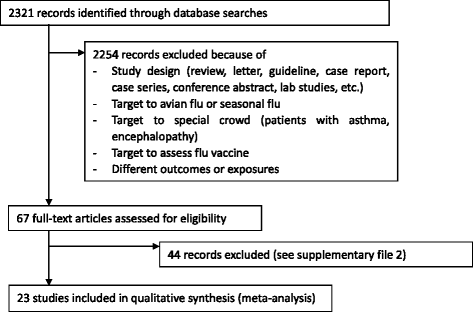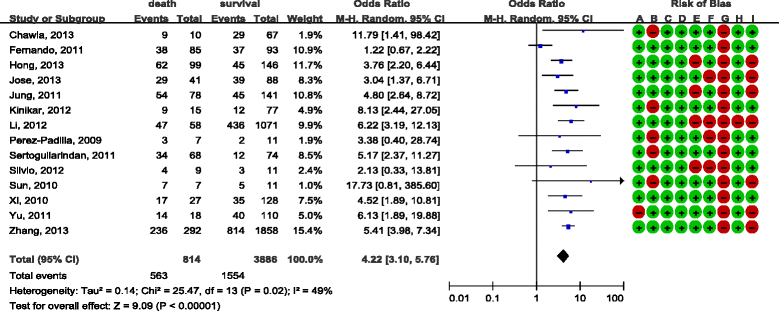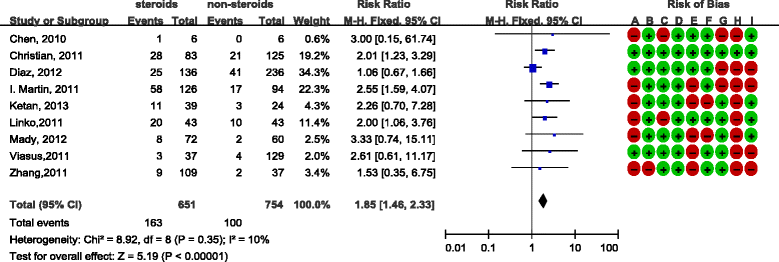Do corticosteroids reduce the mortality of influenza A (H1N1) infection? A meta-analysis
- PMID: 25888424
- PMCID: PMC4348153
- DOI: 10.1186/s13054-015-0764-5
Do corticosteroids reduce the mortality of influenza A (H1N1) infection? A meta-analysis
Abstract
Introduction: Corticosteroids are used empirically in influenza A (H1N1) treatment despite lack of clear evidence for effective treatment. This study aims to assess the efficacy of corticosteroids treatment for H1N1 infection.
Methods: Systematic review and meta-analysis were used to estimate the efficacy of corticosteroids for the prevention of mortality in H1N1 infection. Databases searched included MEDLINE, EMBASE, PubMed, Cochrane Central Register of Controlled Clinical Trials and so on, and bibliographies of retrieved articles, from April 2009 to October 2014. We included both cohort studies and case-control studies reported in English or Chinese that compared treatment effects between corticosteroids and non-corticosteroids therapy in inpatients with H1N1 virus infection. Cohort studies employed mortality as outcome, and case-control studies employed deaths as cases and survivors as controls; both were assessed in this meta-analysis.
Results: In total twenty-three eligible studies were included. Both cohort studies (nine studies, n = 1,405) and case-control studies (14 studies, n = 4,700) showed a similar trend toward increased mortality (cohort studies relative risk was 1.85 with 95% confidence interval (CI) 1.46 to 2.33; case-control studies odds ratio was 4.22 with 95% CI 3.10 to 5.76). The results from both subgroup analyses and sensitive analyses were consistent with each other, showing that steroid treatment is associated with mortality. However, considering the fact that corticosteroids were tend to be used in sickest case-patients and heterogeneity was observed between studies, we cannot make a solid conclusion.
Conclusions: Available evidence did not support the use of corticosteroids as standard care for patients with severe influenza. We conclude that further research is required.
Figures



References
-
- Libster R, Bugna J, Coviello S, Hijano DR, Dunaiewsky M, Reynoso N, et al. Pediatric hospitalizations associated with 2009 pandemic influenza A (H1N1) in Argentina. N Engl J Med. 2010;362:45–55. - PubMed
-
- Louie J, Acosta M, Winter K, Jean C, Gavali S, Schechter R, et al. Factors associated with death or hospitalization due to pandemic 2009 influenza A(H1N1) infection in California. J Am Med Assoc. 2009;302:1896–1902. - PubMed
-
- Jain S, Kamimoto L, Bramley AM, Schmitz AM, Benoit SR, Louie J, et al. Hospitalized patients with 2009 H1N1 influenza in the United States, April–June 2009. N Engl J Med. 2009;361:1935–1944. - PubMed
-
- Dominguez-Cherit G, Lapinsky SE, Macias AE, Pinto R, Espinosa-Perez L, de la Torre A, et al. Critically Ill patients with 2009 influenza A(H1N1) in Mexico. J Am Med Assoc. 2009;302:1880–1887. - PubMed
-
- Kumar A, Zarychanski R, Pinto R, Cook DJ, Marshall J, Lacroix J, et al. Critically ill patients with 2009 influenza A(H1N1) infection in Canada. J Am Med Assoc. 2009;302:1872–1879. - PubMed
Publication types
MeSH terms
Substances
LinkOut - more resources
Full Text Sources
Other Literature Sources
Medical
Miscellaneous

